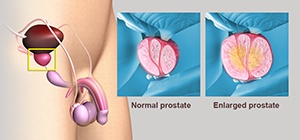
What is Enlarged Prostate or Benign Prostatic Hypertrophy?
Benign Prostatic Hypertrophy or BPH is a non-cancerous enlargement of the prostate gland. It is also referred to as Benign Prostatic Hyperplasia. It is not uncommon for the prostate gland to become enlarged as men age. When the prostate gland becomes enlarged, it can cause problems with urination.
It is common for the prostate gland to become enlarged as a man ages. Doctors call this condition benign prostatic hyperplasia (BPH), or benign prostatic hypertrophy. As the prostate enlarges, the layer of tissue surrounding it stops it from expanding, causing the gland to press against the urethra like a clamp on a garden hose. The bladder wall becomes thicker and irritable. The bladder begins to contract even when it contains small amounts of urine, causing more frequent urination. Eventually, the bladder weakens and loses the ability to empty itself, so some of the urine remains in the bladder. The narrowing of the urethra and partial emptying of the bladder cause many of the problems associated with BPH.
Symptoms of Enlarged Prostate
BPH rarely causes symptoms before age 40, but more than half of men in their sixties and as many as 90 percents in their seventies and eighties have some symptoms of BPH. Many symptoms of BPH stem from obstruction of the urethra and gradual loss of bladder function, which results in incomplete emptying of the bladder. The symptoms of BPH vary, but the most common ones involve changes or problems with urination, such as: hesitant, interrupted, weak stream urgency and leaking or dribbling more frequent urination, especially at night.
Sometimes, a man may not know he has any obstruction until he suddenly finds himself unable to urinate at all. This condition, called acute urinary retention, may be triggered by taking over-the-counter cold or allergy medicines. Such medicines contain a decongestant drug, known as a sympathomimetic. A potential side effect of this drug may prevent the bladder from opening from relaxing and allowing urine to empty. When partial obstruction is present, urinary retention also can be brought on by alcohol, cold temperatures, or a long period of immobility.
Causes of Enlarged Prostate
The cause of BPH is not well understood. No definite information on risk factors exists. For centuries, it has been known that BPH occurs mainly in older men and that it doesn't develop in men whose testes were removed before puberty. For this reason, some researchers believe that factors related to aging and the testes may spur the development of BPH.
One theory focuses on DHT, a substance made from testosterone in the prostate that may help control prostate growth. The accumulation of DHT in older men may encourage the growth of cells leading to BPH.
Another theory suggests elevated estrogen levels that occur as men age may increase cellular growth activity leading to BPH.
Diagnosis of Enlarged Prostate
You may first notice symptoms of BPH yourself, or your doctor may find that your prostate is enlarged during a routine checkup. When BPH is suspected, you may be referred to a urologist, a doctor who specializes in problems of the urinary tract and the male reproductive system. Some tests your doctor may order can include the following:
- Digital Rectal Examination (DRE): This examination is usually the first test done. The doctor inserts a gloved finger into the rectum and feels the part of the prostate next to the rectum. This examination gives the doctor a general idea of the size and condition of the gland.
- Prostate-Specific Antigen (PSA) Blood Test: To rule out cancer as a cause of urinary symptoms, your doctor may recommend a PSA blood test. PSA, a protein produced by prostate cells, is frequently present at elevated levels in the blood of men who have prostate cancer. The National Comprehensive Cancer Network recommends that PSA be used as a screening test for prostate cancer in men between ages 45 and 75, depending on their risk factors.
- Rectal Ultrasound and Prostate Biopsy: If there is a suspicion of prostate cancer, your doctor may recommend a test with rectal ultrasound. In this procedure, a probe inserted in the rectum directs sound waves at the prostate. The echo patterns of the sound waves form an image of the prostate gland on a display screen. To determine whether an abnormal-looking area is indeed a tumor, the doctor can use the probe and the ultrasound images to guide a biopsy needle to the suspected tumor. The needle collects a few pieces of prostate tissue for examination with a microscope.
- Urine Flow Study: Your doctor may ask you to urinate into a special device that measures how quickly the urine is flowing. A reduced flow often suggests BPH.
- Cystoscopy: In this examination, the doctor inserts a small tube through the opening of the urethra in the penis. This procedure is done after a solution numbs the inside of the penis so all sensation is lost. The tube, called a cystoscope, contains a lens and a light system that help the doctor see the inside of the urethra and the bladder. This test allows the doctor to determine the size of the gland and identify the location and degree of the obstruction.
Treatment for Enlarged Prostate
Conservative treatment measures to treat BPH are always considered first before invasive measures such as surgery. Some conservative treatment measures include the following:
- Medications: Medications serve as the main treatment strategy for prostate enlargement. At times, however, prostate enlargement can be managed with simple lifestyle changes such as reducing caffeinated beverages or avoiding decongestants which are found in many allergy medications. Medications that are prescribed for prostate enlargement either relax open the prostate area, or reduce the size of the prostate to allow better urine flow.
If medications or lifestyle changes are ineffective there are office-based procedures as well as surgical procedures available to treat prostate enlargement. Most men have options in terms of treatment choices. A careful assessment in the office is important to tailor an effective treatment plan.
Some of the treatment options available include:
- Transurethral resection of the prostate (TURP) – This serves as the gold standard for treatment of prostate enlargement. It involves removing small tissue pieces of the prostate from inside the gland using a scope through the urethra. Routinely, men stay overnight and are discharged the following morning from the hospital.
- Laser vaporization of the prostate – Many lasers are available to treat prostate enlargement. The laser vaporizes prostate tissue to allow an open prostate channel similar to what a TURP accomplishes. Many of these procedures can be performed on an outpatient basis.
- Transurethral incision of the prostate – this involves making two small incisions of the prostate gland through a scope to allow it to relax and open to provide better urine flow. It generally is offered to men with smaller prostate glands who have obstructive urinary symptoms. It is typically an outpatient procedure.
- Prostate urethral lift – This procedure involves the insertion of one or more permanent implants into the prostate, which retract prostatic tissue and maintain an expanded urethral lumen.
- Water jet ablation – An ultrasound guided water jet is used to open up the tissue of the prostate, after which your physician will clean about any remaining obstructions. This procedure may be done as outpatient, or for men with very large prostates, with an overnight stay.
- Prostatic artery embolization – in a process similar to a cardiac catheterization for heart disease, an interventional radiologist obstruct the blood vessels that feed the prostate, causing shrinkage over time. This technique is relatively new, but can be a good option for men who are unsafe to undergo other procedures.
